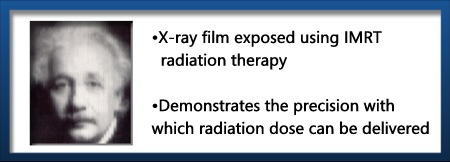|
External radiation delivered from a high energy X-ray machine called a linear accelerator has been
effectively used to treat prostate cancer for more than 30 years. In recent years, there have been several major technological
advances allowing cure rates that typically exceed those of surgery and proton beam therapy, with far fewer side effects.

With intensity modulated radiation therapy (IMRT), sophisticated computers modulate the intensity
of the radiation beam, increasing it to areas where cancer cells reside, and decreasing it to areas that need to be protected.
This allows for maximum radiation to be delivered to the prostate and areas potentially harboring cancer cells, while minimizing
radiation to the bladder and rectum. Patients with intermediate to advanced stage prostate cancer have a high risk of having
cancer outside the prostate, beyond the surgeon's reach. Unlike surgery, IMRT can treat this area.
With intensity modulated radiation therapy (IMRT), sophisticated computers modulate the intensity
of the radiation beam, increasing it to areas where cancer cells reside, and decreasing it to areas that need to be protected.
This allows for maximum radiation to be delivered to the prostate and areas potentially harboring cancer cells, while minimizing
radiation to the bladder and rectum. Patients with intermediate to advanced stage prostate cancer have a high risk of having
cancer outside the prostate, beyond the surgeon's reach. Unlike surgery, IMRT can treat this area.
 
Image Guided Radiation Therapy (IGRT) takes IMRT one step further. Various imaging technologies such
as Cone-beam ® CT scan and tracking of implanted gold fiducial markers are utilized before each daily treatment, to acquire
a 3-dimensional image of the prostate and surrounding anatomy. Computers detect any slight change in position of the prostate
gland that may result from movement or variations in filling of the bladder or rectum. Using this information, the computer
adjusts the radiation beam accordingly in order to precisely target the treatment to the prostate's exact position that day.
Changes as small as 1 millimeter are made to provide the greatest precision available. IGRT is the newest and most advanced
system for the delivery of radiation, allowing much greater precision than proton therapy.
We are one of the only centers in the world doing MRI treatment planning for prostate cancer. Prior to
beginning IGRT treatment, our patients undergo this special MRI scan and a CT scan in our department. The information from
the 2 scans in entered into our specialized computers and a customized treatment plan is created, tailored to fit each patient's
anatomy precisely. IGRT is typically given for only a few minutes a day, five days a week. When combined with a seed implant,
this part of the treatment is approximately 5 weeks long. If given without a seed implant, the treatment is typically for
8 1/2 weeks. IGRT is completely painless and non-invasive. The most commonly reported side effects during
treatment are slight fatigue and having to go to the bathroom more frequently. You will NOT develop any nausea, abdominal
pain, hair loss, or skin burning. You will NOT lose your ability to control your bowels or bladder. You will be able to continue
working full-time and should enjoy all of your regular activities.

|
Why is IMRT / IGRT better than Protons- Increased dose conformality with IMRT vs. Protons
- Smaller
volume of normal tissue around the prostate treated to high doses
- Less uncertainty in dose deposition
- Lower
volumes of normal tissue treated to high doses
- More sophisticated image guidance with 3D volumetric instead of planar
images
- Potential rectal sparing due to the air in the rectal balloon
- Superior clinical results
|
High Dose Radiation Outcomes (Viani et al IJROBP
2009)
| |
|
|
|
|
T1c-T2a, Gleason ≤6, and PSA <10 |
|
|
|
T2b or Gleason 7 or PSA 10-20 |
|
|
High risk
|
T2c-T3, Gleason 8-10, or PSA ≥20 |
|
|